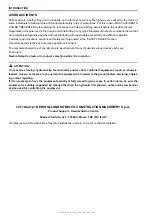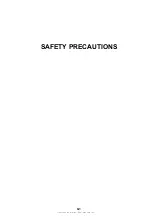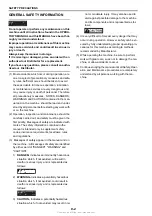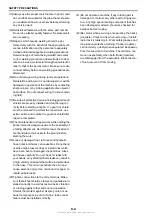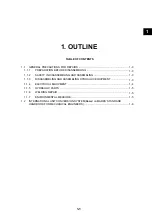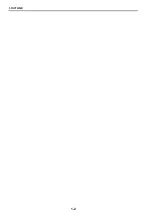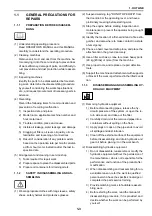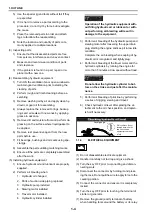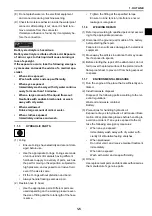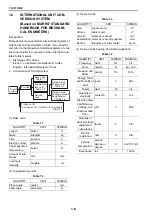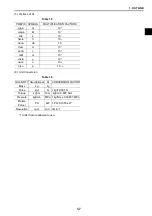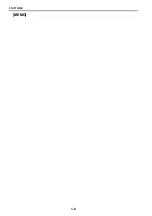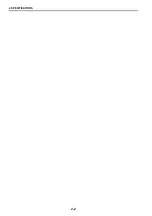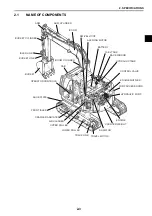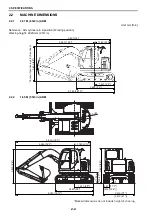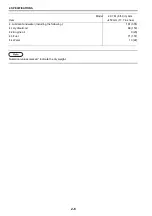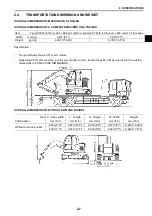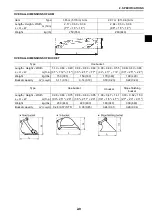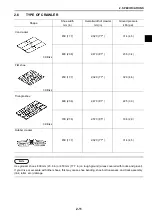
1. OUTLINE
1-4
5) Use the special jig and tools without fail if they
are specified.
6) If it is hard to remove a part according to the
procedure, do not try it by force but investigate
the cause.
7) Place the removed parts in order and attach
tags to facilitate the reassembling.
8) Note the location and quantity of parts com-
monly applied to multiple locations.
(3) Inspecting parts
1) Ensure that the disassembled parts are free
from seizure, interference and uneven contact.
2) Measure and record wear condition of parts
and clearance.
3) If the problem is found in a part, repair or re-
place it with a new one.
(4) Reassembling hydraulic equipment
1) Turn ON the ventilation fan or open windows to
maintain good ventilation prior to starting the
cleaning of parts.
2) Perform rough and finish cleaning before as-
sembling.
3) Remove washing oil by air and apply clean hy-
draulic or gear oil for assembling.
4) Always replace the removed O-rings, backup
rings and oil seals with new ones by applying
grease in advance.
5) Remove dirt and moisture from and perform de-
greasing on the surface where liquid gasket to
be applied.
6) Remove rust preventive agent from the new
parts before use.
7) Fit bearings, bushings and oil seals using spe-
cial jigs.
8) Assemble the parts utilizing matching marks.
9) Ensure all the parts are completely assembled
after the work.
(5) Installing hydraulic equipment
1) Ensure hydraulic oil and lubricant are properly
supplied.
2) Perform air bleeding when:
1. Hydraulic oil changed
2. Parts of suction side piping replaced
3. Hydraulic pump installed
4. Slewing motor installed
5. Travel motor installed
6. Hydraulic cylinder installed
Operation of the hydraulic equipment with-
out filling hydraulic oil or lubricant or with-
out performing air bleeding will result in
damage to the equipment.
3) Perform air bleeding of the hydraulic pump and
slewing motor after loosening the upper drain
plug, starting the engine and keep it in low idle
condition.
Complete the air bleeding when seeping of hy-
draulic oil is recognized, and tightly plug.
4) Perform air bleeding of the travel motor and the
hydraulic cylinders by running the engine for
more than 5 minutes at low speed without load.
Do not allow the hydraulic cylinder to bot-
tom on the stroke end just after the mainte-
nance.
5) Perform air bleeding of pilot line by performing
a series of digging, slewing and travel.
6) Check hydraulic oil level after placing the at-
tachment to the oil check position, and replen-
ish oil if necessary.
1.1.4
ELECTRICAL EQUIPMENT
(1) Do not disassemble electrical equipment.
(2) Handle it carefully not to drop and give a shock.
(3) Turn the key OFF prior to connecting and discon-
necting work.
(4) Disconnect the connector by holding it and press-
ing the lock. Do not pull the wire to apply force to the
caulking portion.
(5) Connect the connector and ensure it is completely
locked.
(6) Turn the key OFF prior to touching the terminal of
starter or generator.
(7) Remove the ground (earth) terminal of battery
when handling tools around the battery or its relay.
Level gauge
Oil level lines (Level
located between the
two lines shows
appropriate amount
of oil)
Содержание E70SR
Страница 2: ...Find manuals at https best manuals com ...
Страница 5: ...0 1 SAFETY PRECAUTIONS Find manuals at https best manuals com ...
Страница 12: ...1 OUTLINE 1 2 ...
Страница 18: ...1 OUTLINE 1 8 MEMO ...
Страница 20: ...2 SPECIFICATIONS 2 2 ...
Страница 34: ...2 SPECIFICATIONS 2 16 MEMO ...
Страница 36: ...3 ATTACHMENT DIMENSIONS 3 2 ...
Страница 51: ...This as a preview PDF file from best manuals com Download full PDF manual at best manuals com ...




